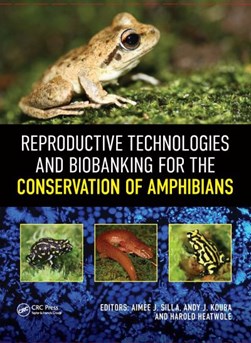-
BROWSE 1000s OF BOOKS IN STOCK
-
FREE DELIVERY ON ORDERS OVER €10
Reproductive technologies and biobanking for the conservation of amphibians
Hardback
How to decelerate loss of global biodiversity is one of the greatest challenges of our generation. Reproductive technologies have enormous potential to assist the recovery of species by enhancing reproductive output, facilitating genetic management, and supporting reintroduction of threatened species. Of particular value are cryopreservation technologies coupled with the establishment of global gene banks to conserve, in perpetuity, the remaining extant genetic diversity of threatened amphibians. Reproductive Technologies and Biobanking for the Conservation of Amphibians brings together leading experts in the field to provide a comprehensive overview of current best practices, summarise technological advancements, and present a framework for facilitating the integration of reproductive technologies and biobanking into conservation breeding programs for threatened amphibians. It is an invaluable reference for the next generation of conservation practitioners: captive breeding facilities, researchers, and policy-makers involved with biodiversity conservation
€110.20

330 Reward Points
In stock online
Extended Range: Delivery in 2-3 working days
Extended Range: Delivery in 2-3 working days
Free Delivery on this item
Any purchases for more than €10 are eligible for free delivery anywhere in the UK or Ireland!
How to decelerate loss of global biodiversity is one of the greatest challenges of our generation. Reproductive technologies have enormous potential to assist the recovery of species by enhancing reproductive output, facilitating genetic management, and supporting reintroduction of threatened species. Of particular value are cryopreservation technologies coupled with the establishment of global gene banks to conserve, in perpetuity, the remaining extant genetic diversity of threatened amphibians. Reproductive Technologies and Biobanking for the Conservation of Amphibians brings together leading experts in the field to provide a comprehensive overview of current best practices, summarise technological advancements, and present a framework for facilitating the integration of reproductive technologies and biobanking into conservation breeding programs for threatened amphibians. It is an invaluable reference for the next generation of conservation practitioners: captive breeding facilities, researchers, and policy-makers involved with biodiversity conservation

330 Reward Points
Any purchases for more than €10 are eligible for free delivery anywhere in the UK or Ireland!
€110.20

330 Reward Points
Any purchases for more than €10 are eligible for free delivery anywhere in the UK or Ireland!
Product Description
How to decelerate loss of global biodiversity is one of the greatest challenges of our generation. Reproductive technologies have enormous potential to assist the recovery of species by enhancing reproductive output, facilitating genetic management, and supporting reintroduction of threatened species. Of particular value are cryopreservation technologies coupled with the establishment of global gene banks to conserve, in perpetuity, the remaining extant genetic diversity of threatened amphibians. Reproductive Technologies and Biobanking for the Conservation of Amphibians brings together leading experts in the field to provide a comprehensive overview of current best practices, summarise technological advancements, and present a framework for facilitating the integration of reproductive technologies and biobanking into conservation breeding programs for threatened amphibians. It is an invaluable reference for the next generation of conservation practitioners: captive breeding facilities, researchers, and policy-makers involved with biodiversity conservation
Product Details
ISBN9781032372075
FormatHardback
PublisherCRC PRESS (15 November. 2022)
No. of Pages248
Weight1040
Language English
Dimensions 280 x 277 x 21

